Cheesesteak Stuffed Bread with Roasted Garlic Butter
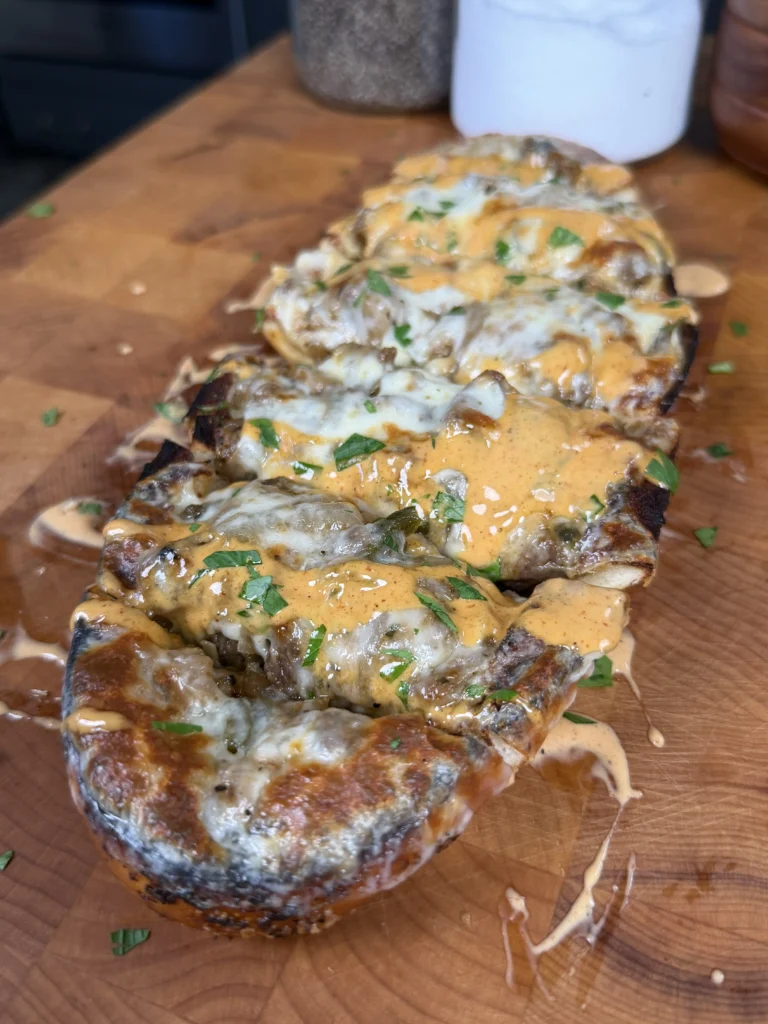
Cheesesteak stuffed bread takes the classic Philly cheesesteak and transforms it into a shareable, party-friendly format by stuffing an entire loaf with tender chopped ribeye, caramelized onions, smoky poblano peppers, and a molten blend of Oaxaca and provolone cheese. This recipe starts with roasted garlic that gets mashed into softened butter with fresh parsley, creating a rich spread that gets brushed inside the bread before toasting. The filling features thinly sliced ribeye seared until just browned, sweet onions caramelized until deeply golden, and poblano peppers cooked until soft and slightly charred. Everything gets layered into a hinged French loaf with generous amounts of stretchy Oaxaca cheese and sharp provolone, then wrapped in foil and grilled or baked until the cheese melts completely.
What makes this grilled cheesesteak loaf special is how cooking over indirect heat on the grill adds subtle smokiness that elevates it beyond a regular sandwich, while the roasted garlic butter seeps into the bread creating incredible flavor throughout. The combination of Oaxaca and provolone creates the ultimate cheese pull – Oaxaca melts into stretchy, stringy perfection while provolone adds creamy, sharp character. Slicing the finished loaf into two-inch pieces creates individual portions perfect for serving at parties, tailgates, or game day gatherings. This Philly cheesesteak bread delivers all the classic flavors you love in a format that feeds a crowd and looks incredibly impressive when you slice it open to reveal the melted cheese and tender steak.
Why Ribeye Is the Best Choice for Cheesesteak
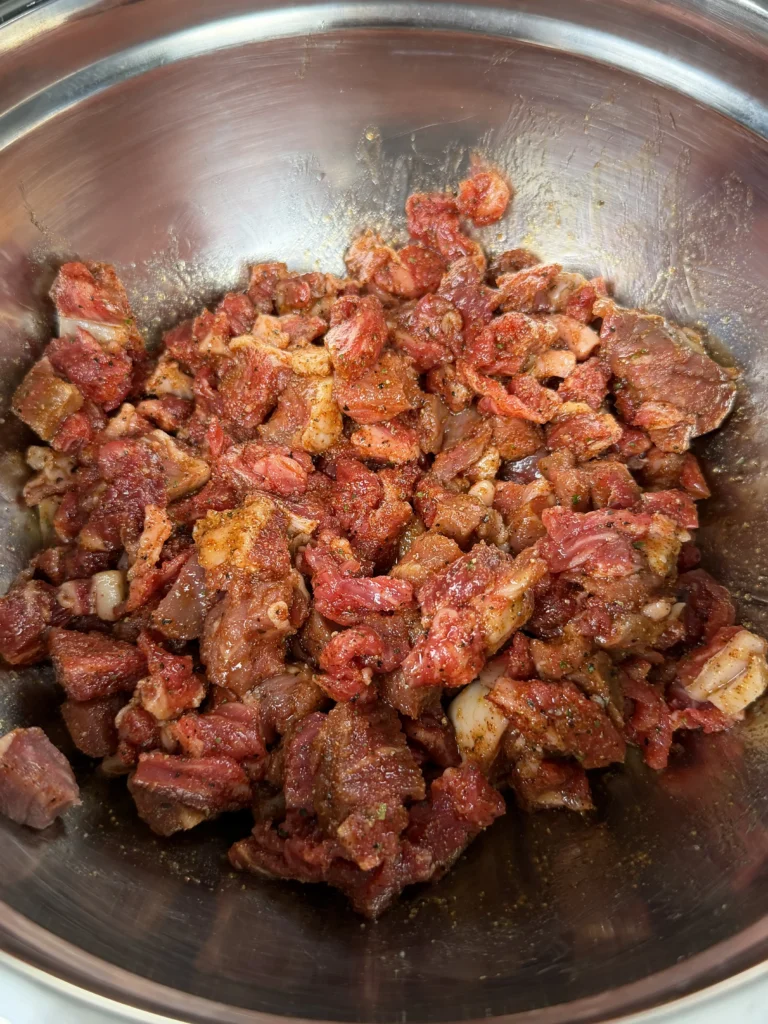
Ribeye steak is the gold standard for authentic Philly cheesesteaks because of its abundant marbling, tender texture, and rich beef flavor. The intramuscular fat in ribeye – those white streaks running through the meat – melts during cooking, creating incredibly juicy, flavorful meat that stays moist even when cooked well-done as traditional cheesesteak requires. Leaner cuts like sirloin or round would become tough and dry with the same cooking method. The ribeye’s tender muscle structure also allows it to be sliced paper-thin without falling apart or becoming stringy.
For authentic cheesesteak texture, the ribeye should be sliced as thinly as possible – ideally shaved on a meat slicer to near translucency. If you don’t have a slicer at home, ask your butcher to shave the ribeye for you, or partially freeze it for thirty to forty-five minutes which firms it up enough to slice extremely thin with a sharp knife. Some people prefer chopped ribeye rather than shaved – both styles are authentic to different Philly cheesesteak shops. Chopped ribeye creates more textural interest with varied bite sizes and more crispy, caramelized edges. One pound of ribeye provides substantial filling for one large loaf that serves six to eight people.
The Science of Caramelizing Onions
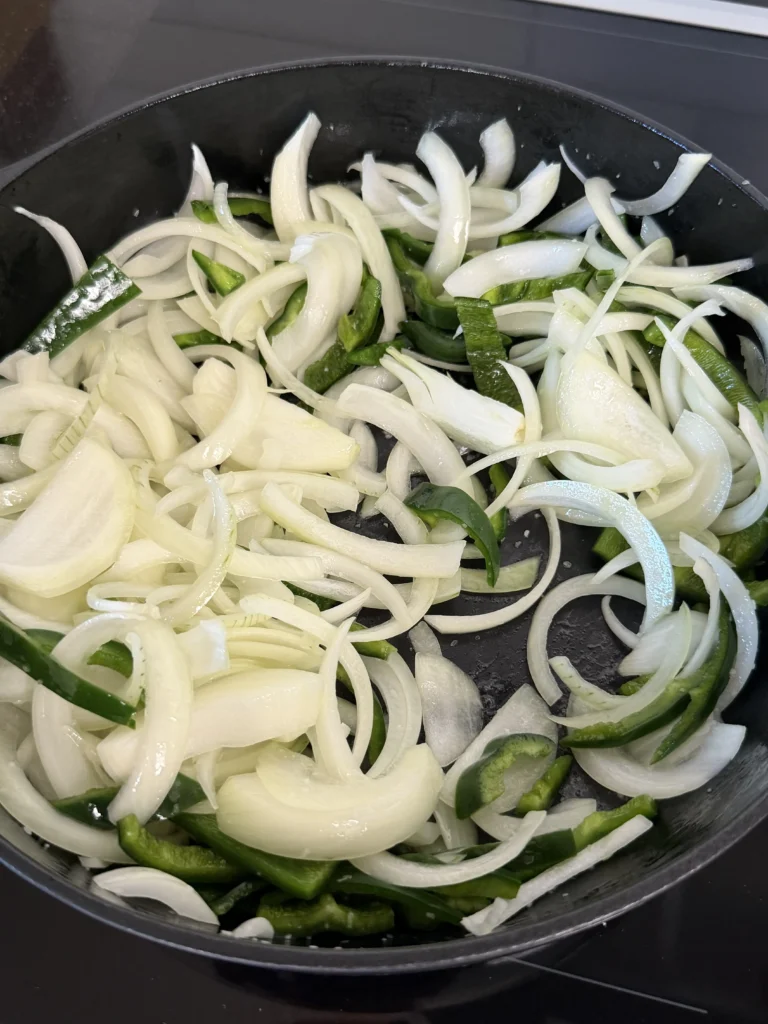
Properly caramelized onions are essential to great cheesesteak, providing sweet, complex flavor that balances the rich meat and cheese. Caramelization is a chemical process where the natural sugars in onions break down and recombine at high heat, creating hundreds of new flavor compounds that taste sweet, nutty, and deeply savory. This transformation takes time – fifteen to twenty minutes minimum for proper caramelization. Rushing the process by using high heat burns the onions rather than caramelizing them, creating bitter rather than sweet flavor.
Sweet onions like Vidalia, Walla Walla, or Maui work best because they contain more natural sugar than yellow storage onions, creating sweeter results. However, regular yellow onions work fine and are more readily available. Slice the onions thinly and uniformly so they cook at the same rate. Cook over medium heat with just enough oil to coat the pan – too much oil makes them greasy rather than caramelized. Stir occasionally but not constantly – letting them sit allows contact with the hot pan that creates browning. Add a pinch of salt early in cooking which draws out moisture and speeds caramelization. The onions are done when they’ve shrunk dramatically, turned deep golden brown, and taste intensely sweet.
Understanding Poblano Peppers
Poblano peppers provide mild heat and smoky, earthy flavor that’s traditional to many Mexican and Tex-Mex preparations but works beautifully in cheesesteak applications. Poblanos are large, dark green chilies with broad shoulders and relatively mild heat – typically 1,000 to 2,000 Scoville units, similar to or milder than jalapeños. Their size makes them easy to seed and slice into strips. The thick flesh provides substantial texture and vegetable presence rather than just heat. When cooked, poblanos develop sweet, almost fruity notes alongside their characteristic earthiness.
Roasting poblanos over direct flame before slicing adds another layer of flavor through char and smoke. The charred skin contributes slight bitterness that balances sweetness, while the flesh becomes more tender and concentrated in flavor. If you don’t want to char them separately, cooking them in the skillet with the onions still develops good flavor, though without the smoky, charred notes. For those who don’t enjoy any heat, bell peppers substitute well – use one green bell pepper sliced thin. The flavor profile changes slightly but the vegetable component remains.
Roasted Garlic vs. Raw Garlic
Roasting garlic transforms its character from sharp and pungent to sweet, mellow, and almost nutty. Raw garlic contains allicin and other sulfur compounds that provide its characteristic bite. When roasted at moderate heat for thirty-five to forty minutes, these compounds break down while the garlic’s natural sugars caramelize, creating completely different flavor. Roasted garlic becomes so mild and sweet you can eat entire cloves without the burning sensation raw garlic creates. The soft, paste-like consistency of roasted garlic also makes it perfect for spreading or mixing into butter.
Roasting an entire head of garlic is simple: slice off the top quarter-inch to expose the clove tops, drizzle with olive oil, wrap in foil, and roast until the cloves are soft and golden. The olive oil prevents drying and adds richness. Squeezing the roasted cloves from their papery skins is satisfying – they slip out easily as soft, caramelized paste. One head of roasted garlic provides enough for the butter with some left over. Roasted garlic keeps refrigerated for up to one week or can be frozen for up to three months, making it worthwhile to roast multiple heads at once.
The Perfect Cheese Combination
The blend of Oaxaca and provolone creates ideal texture and flavor for cheesesteak. Oaxaca cheese – a Mexican string cheese similar to mozzarella – has exceptional melting properties and creates those dramatic cheese pulls that make food photos irresistible. When heated, Oaxaca becomes incredibly stretchy and gooey without separating into oil and solids the way some cheeses do. Its mild, slightly tangy flavor doesn’t overpower the beef. Shredded Oaxaca distributed throughout the filling ensures cheese in every bite rather than concentrated in one spot.
Provolone adds sharp, tangy character that Oaxaca lacks. The aged Italian cheese has more pronounced flavor with slight saltiness and nuttiness that complements beef beautifully. Sliced provolone melts smoothly and adds creaminess. Using both cheeses creates more complex, interesting flavor than either alone would provide. If Oaxaca isn’t available, substitute low-moisture mozzarella which has similar melting properties though slightly less stretch. Some people prefer American cheese for authentic Philly style – it melts extremely well and adds creamy, salty character, though many consider it less sophisticated than the Oaxaca-provolone combination.
Ingredients
For the Roasted Garlic Butter:
- 1 head garlic
- 2 tbsp olive oil
- 1 stick (½ cup) unsalted butter, softened
- 1 tbsp fresh parsley, finely chopped
- Salt and black pepper, to taste
For the Cheesesteak Filling:
- 1 lb ribeye steak, thinly sliced or chopped
- 1 large sweet onion, thinly sliced
- 1 poblano pepper, seeded and thinly sliced
- 2 tbsp olive oil or ghee
- Salt and pepper, to taste
- 1 tsp Worcestershire sauce (optional)
For Assembly:
- 1 large French or Italian loaf
- 1½ cups shredded Oaxaca cheese
- 6-8 slices provolone cheese
- Fresh parsley, for garnish (optional)
Step-by-Step Instructions
Roast the Garlic for Butter
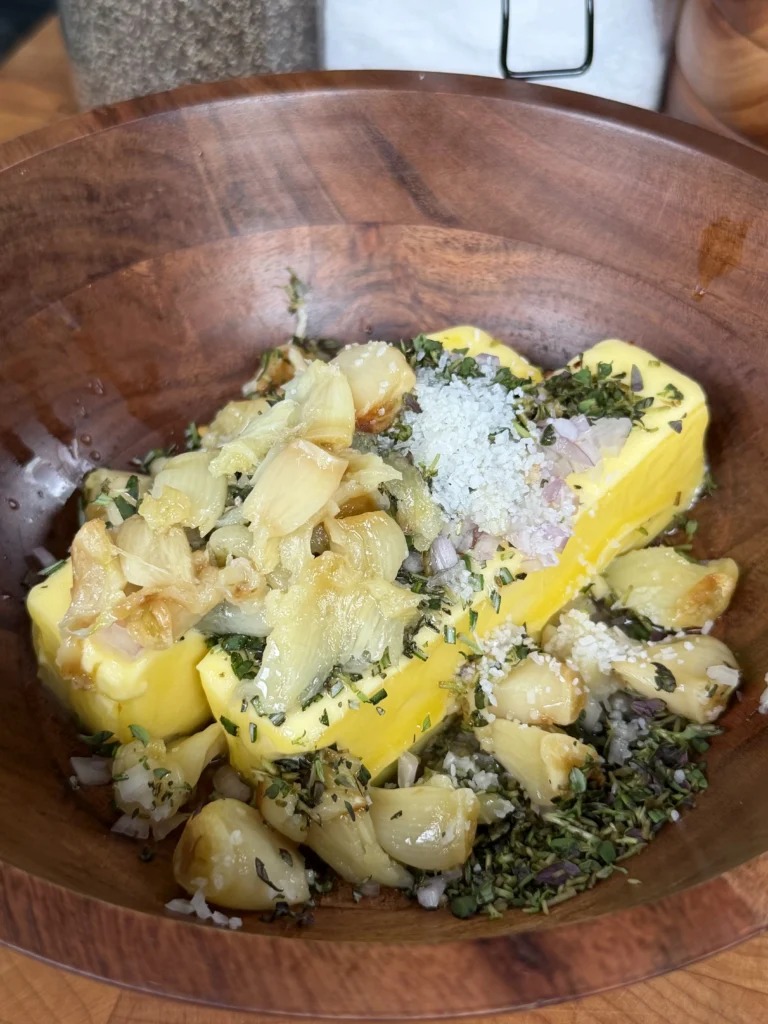
Preheat your grill to 400 degrees Fahrenheit or your oven if cooking indoors. Take one whole head of garlic and slice off the top quarter-inch to expose the tops of all the cloves. Place the garlic head cut-side up on a square of aluminum foil large enough to wrap it completely. Drizzle two tablespoons of olive oil over the exposed cloves, letting it seep down into the head. The oil prevents drying and adds richness during roasting.
Wrap the garlic tightly in the foil, creating a sealed packet. Place on the grill over indirect heat or in the preheated oven. Roast for thirty-five to forty minutes until the cloves are very soft, golden brown, and caramelized. You’ll know it’s done when the cloves feel soft when pressed and have darkened to light golden color. Let the garlic cool in the foil for five to ten minutes until you can handle it safely, then unwrap and squeeze each clove from its papery skin into a small bowl. The roasted cloves should slip out easily as soft paste.
Mash the roasted garlic cloves with a fork until relatively smooth – some small chunks are fine. Add one stick (half cup) of softened unsalted butter to the bowl. The butter should be soft enough to mix easily but not melted. Add one tablespoon of finely chopped fresh parsley, a pinch of salt, and a few grinds of black pepper. Use the fork to mash and stir everything together until the garlic is evenly distributed throughout the butter and the mixture is relatively uniform. Taste and adjust seasoning if needed. Set the roasted garlic butter aside at room temperature – it should stay soft and spreadable.
Caramelize Onions and Poblanos
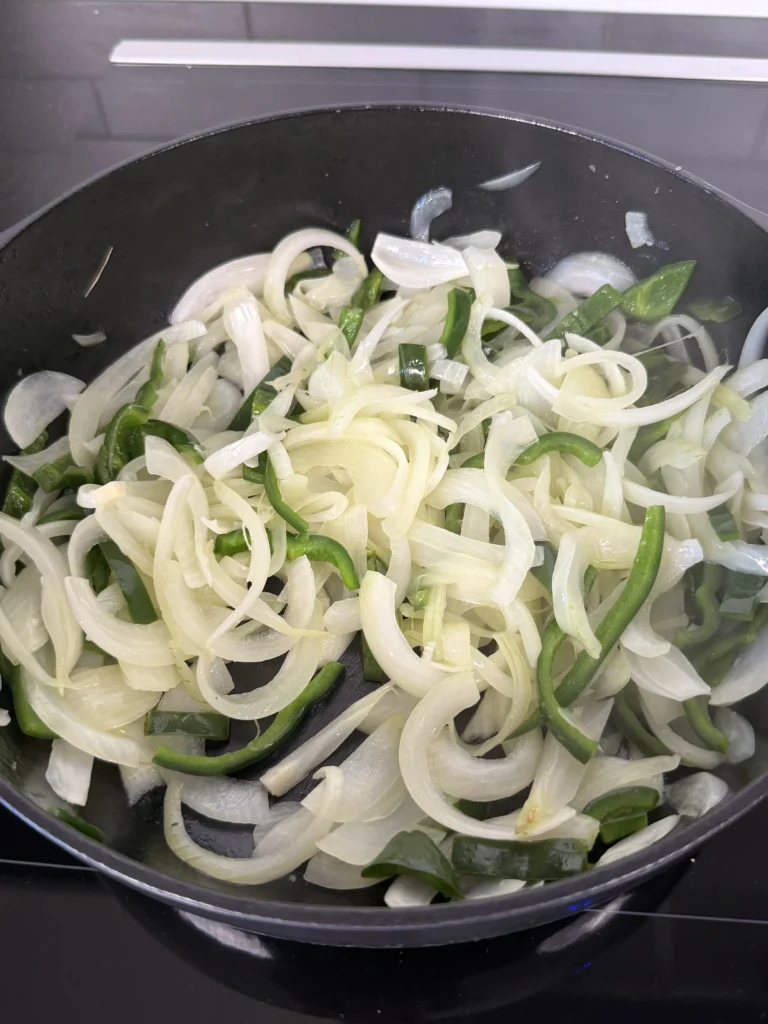
Heat one tablespoon of olive oil or ghee in a large cast iron skillet over medium heat. Add the thinly sliced sweet onion and seeded, thinly sliced poblano pepper to the pan. Sprinkle with a generous pinch of salt which helps draw out moisture and speeds caramelization. Stir to coat the vegetables in oil.
Cook the onions and peppers together, stirring every two to three minutes, for fifteen to twenty minutes total. At first they’ll release moisture and seem to steam, but as the liquid evaporates they’ll begin to brown. Lower the heat slightly if they’re browning too quickly or starting to burn. The onions are done when they’ve shrunk to about a third of their original volume, turned deep golden brown, and taste intensely sweet. The poblanos should be very soft with some charred edges. Transfer the caramelized vegetables to a plate or bowl and set aside. Don’t wash the skillet – you want to keep all the flavorful fond for cooking the steak.
Chop and Sear the Ribeye Steak
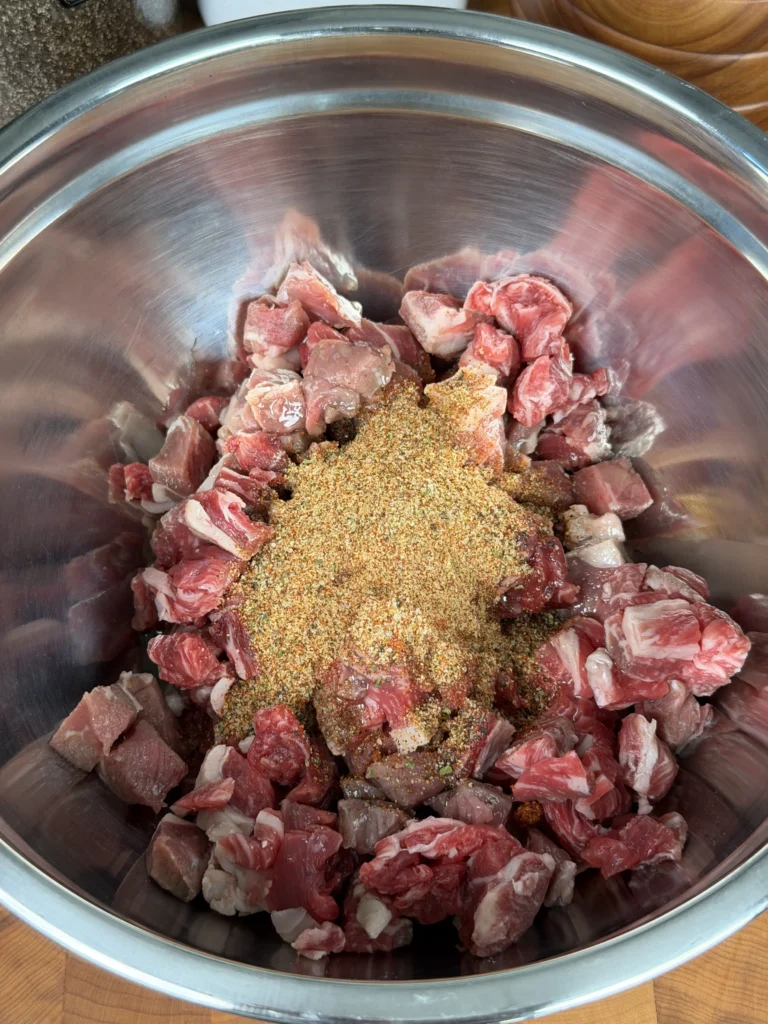
Return the same skillet to medium-high heat and add the remaining tablespoon of olive oil or ghee. Let the pan get hot – the oil should shimmer. Add all the thinly sliced or chopped ribeye to the hot pan, spreading it out as much as possible. Don’t crowd the pan – if necessary, cook the ribeye in two batches for proper searing rather than steaming.
Season the ribeye generously with salt and pepper. If using Worcestershire sauce, drizzle one teaspoon over the meat. Let the ribeye cook undisturbed for one to two minutes to develop browning on the bottom, then stir or flip. Continue cooking for another two to three minutes, stirring occasionally, until the meat is browned but still slightly pink in some areas. The total cooking time should be three to four minutes – you don’t want the ribeye fully cooked at this stage since it will continue cooking in the stuffed bread later.
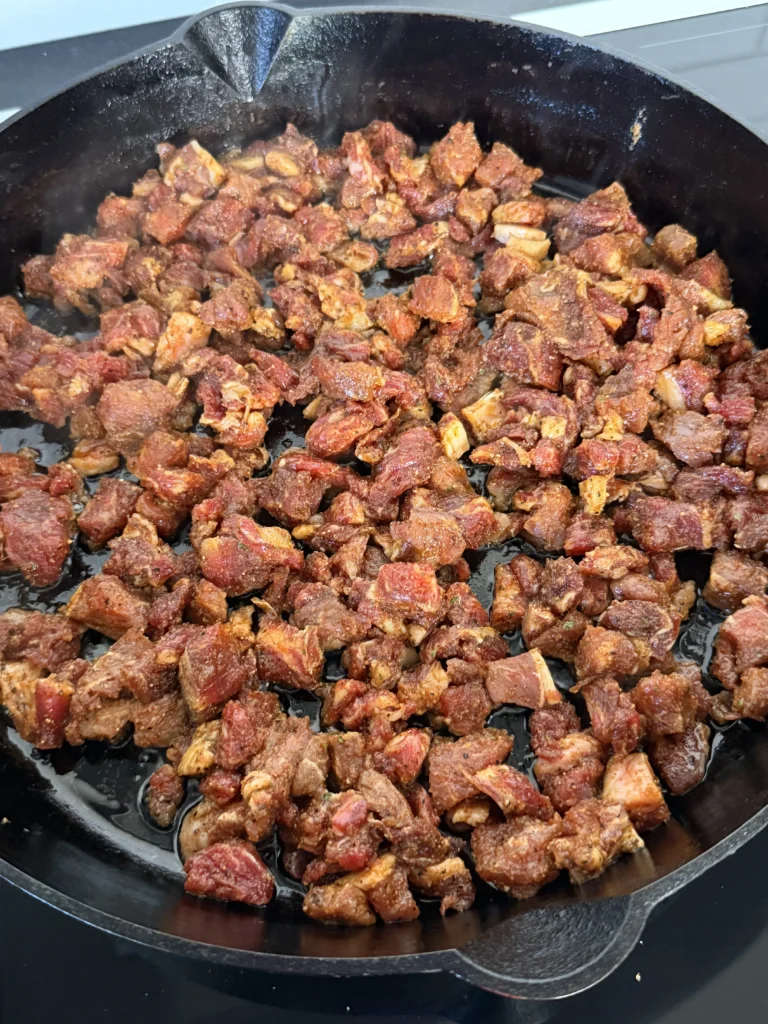
Return the caramelized onions and peppers to the skillet with the ribeye. Toss everything together to combine and heat the vegetables through, about one minute. Remove from heat and let the filling cool slightly while you prepare the bread.
Prepare and Toast the Bread
Take one large French or Italian loaf – approximately sixteen to twenty inches long and four to five inches wide. Place it on a cutting board and use a sharp serrated knife to slice it lengthwise, cutting almost but not completely through so one long edge remains attached like a book hinge. Open the bread like a book with the cut sides facing up.
Generously brush the inside of both halves with the roasted garlic butter, using approximately half of the total butter. Make sure to cover the entire interior surface – the garlic butter will soak into the bread and add incredible flavor. If grilling, place the opened bread cut-side down over indirect heat on the grill and toast for two to three minutes until golden and slightly crispy. If using the oven, place the opened bread cut-side up on a baking sheet and toast in a 400-degree oven for three to four minutes. Watch carefully to prevent burning – you want light golden color and slight crispness. Remove the toasted bread and keep it open for filling.
Assemble the Stuffed Bread
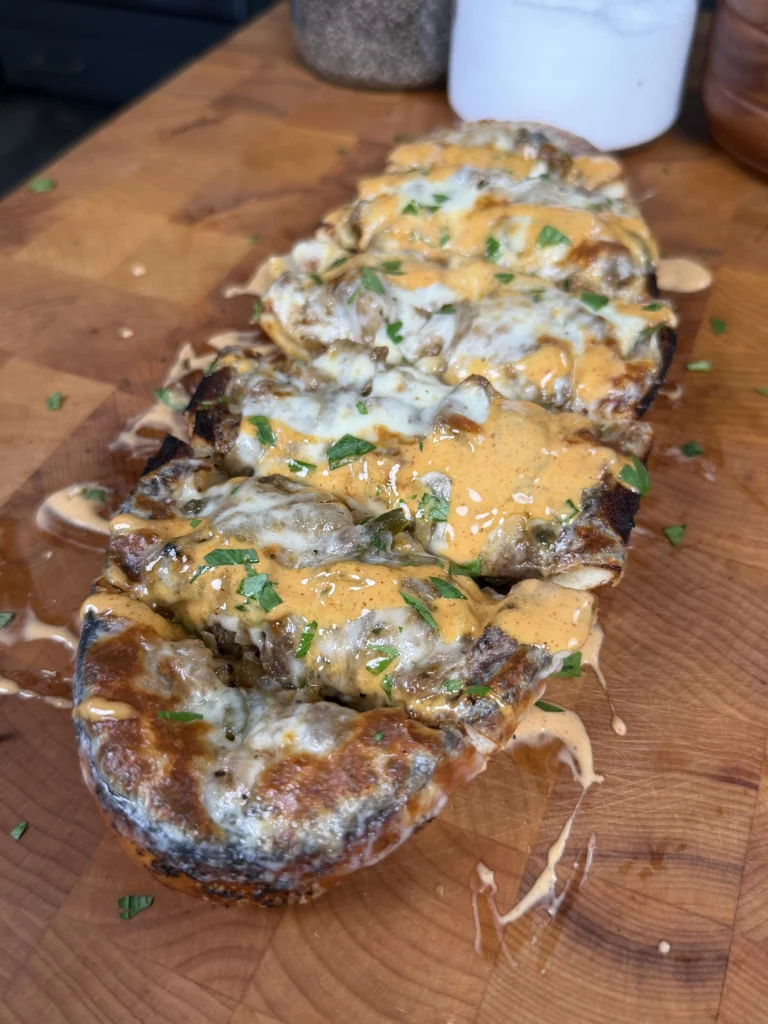
Sprinkle approximately three-quarters of the shredded Oaxaca cheese evenly across the bottom half of the toasted bread. The cheese layer provides a base that will melt up into the filling. Distribute the hot ribeye, onion, and poblano mixture evenly across the Oaxaca cheese, spreading it from edge to edge. The filling should cover the entire length of the bread in a relatively even layer.
Top the ribeye mixture with the remaining Oaxaca cheese, sprinkling it over the meat and vegetables. Layer six to eight slices of provolone cheese across the top, overlapping them slightly to cover all the filling. The provolone creates a blanket that traps heat and melts down into the other ingredients. Gently close the bread, bringing the top half down over the filled bottom half. Press down lightly to compress everything slightly.
Tear off a large sheet of heavy-duty aluminum foil – long enough to wrap the entire loaf with overhang on each end. Place the stuffed bread in the center of the foil and wrap it loosely, creating a packet that’s sealed but not tight. You want the bread to have some room to steam and heat through without the foil pressing directly against the cheese and sticking.
Grill or Bake Until Melted
For grilling (best flavor): Preheat your grill to 375-400 degrees Fahrenheit with one side at medium heat (indirect zone). Place the foil-wrapped stuffed bread on the cooler, indirect side of the grill – not directly over flames or coals. Close the grill lid and cook for fifteen to twenty minutes. The bread should be hot throughout and the cheese completely melted and gooey. For the last five minutes, carefully unwrap the foil to expose the bread and let the crust crisp up from the direct heat. If desired, add a small chunk of hickory or oak wood to the grill for subtle smoke flavor.
For oven baking (indoor option): Preheat your oven to 400 degrees Fahrenheit. Place the foil-wrapped stuffed bread on a large baking sheet and bake for fifteen to twenty minutes until heated through and the cheese is melted. Unwrap the foil for the last five minutes to crisp the crust. For extra crunch and color, switch to broil for the final one to two minutes, watching carefully to prevent burning.
Slice and Serve
Remove the stuffed bread from the grill or oven and let it rest for three to five minutes before slicing – this allows the cheese to set slightly and prevents it from all running out when cut. Use a sharp serrated knife to slice the loaf into two-inch thick pieces, cutting straight down through the bread and filling. Each slice should show beautiful cross-sections of melted cheese, tender steak, and caramelized vegetables.
Arrange the slices on a serving platter or cutting board. Brush any remaining roasted garlic butter over the top crust for extra flavor and shine. Garnish with chopped fresh parsley if desired. Serve immediately while hot with optional dipping sauces like horseradish cream, chipotle mayo, or au jus. The cheesesteak stuffed bread is perfect as a main course with sides like fries, coleslaw, or salad, or as a shareable appetizer for parties and gatherings.
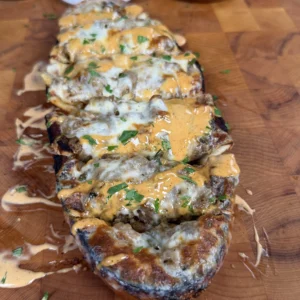
Cheesesteak Stuffed Bread with Roasted Garlic Butter
Ingredients
Roasted Garlic Butter:
- 1 head garlic
- 2 tbsp olive oil
- 1 stick unsalted butter softened
- 1 tbsp fresh parsley chopped
- Salt and pepper
Cheesesteak Filling:
- 1 lb ribeye steak thinly sliced
- 1 large sweet onion sliced
- 1 poblano pepper seeded and sliced
- 2 tbsp olive oil or ghee
- Salt and pepper
- 1 tsp Worcestershire sauce optional
Assembly:
- 1 large French or Italian loaf
- 1½ cups shredded Oaxaca cheese
- 6-8 slices provolone cheese
Instructions
- Preheat grill or oven to 400°F. Slice top off garlic head, drizzle with olive oil, wrap in foil. Roast 35-40 minutes until soft and golden. Squeeze roasted cloves into bowl, mash with softened butter, parsley, salt, and pepper.
- Heat 1 tbsp oil in cast iron skillet over medium heat. Add sliced onion and poblano with pinch of salt. Cook 15-20 minutes, stirring occasionally, until deeply caramelized and golden. Remove and set aside.
- Add remaining oil to same skillet over medium-high heat. Add ribeye, season with salt, pepper, and Worcestershire if using. Cook 3-4 minutes until browned but still slightly pink. Return onions and peppers to pan, toss together, and remove from heat.
- Slice French loaf lengthwise, leaving one side hinged. Brush inside generously with roasted garlic butter. Toast cut-side down on grill for 2-3 minutes or in 400°F oven until golden.
- Layer bottom half with most of the Oaxaca cheese. Add hot ribeye mixture evenly across bread. Top with remaining Oaxaca and provolone slices. Close bread and wrap loosely in foil.
- FOR GRILL: Place on indirect heat side at 375-400°F. Cook 15-20 minutes until cheese melts. Unwrap last 5 minutes to crisp crust. FOR OVEN: Bake at 400°F for 15-20 minutes. Unwrap last 5 minutes, then broil 1-2 minutes for extra crunch.
- Rest 3-5 minutes, then slice into 2-inch pieces. Serve hot with optional dipping sauces.
Notes
Can substitute mozzarella for Oaxaca cheese
Roast poblanos over direct flame first for smokier flavor
Extra garlic butter makes excellent dipping sauce
Assemble ahead and refrigerate up to 4 hours before cooking
Leftover slices reheat well in 350°F oven for 10 minutes
For spicier version, add jalapeños or use pepper jack cheese
Bell peppers can substitute for poblanos if preferred
FAQ
Can I use a different cut of beef instead of ribeye?
While ribeye is ideal for its marbling and tenderness, top sirloin or New York strip can substitute if sliced very thin. These cuts are leaner so they may be slightly less juicy, but they still provide good beef flavor. Avoid tough cuts like round or chuck which won’t become tender with the brief cooking time. Some people use deli roast beef as a shortcut – it works but lacks the fresh-seared flavor of properly cooked ribeye. The key with any cut is slicing as thinly as possible.
What if I can’t find Oaxaca cheese?
Low-moisture mozzarella is the closest substitute, providing similar melting properties and stretch though slightly less dramatic cheese pull. Fresh mozzarella works but contains more moisture which can make the bread soggy. Monterey Jack melts beautifully with mild flavor. For authentic Philly style, use American cheese which melts extremely smooth and creamy. You can also use all provolone, though you’ll lose the exceptional stretch that Oaxaca provides. Most Mexican markets and many regular supermarkets carry Oaxaca in the specialty cheese section.
Can I make this ahead of time?
Yes, assemble the stuffed bread completely up to four hours ahead and refrigerate wrapped in foil. When ready to serve, let it sit at room temperature for twenty minutes, then grill or bake as directed, adding five to ten extra minutes to account for the cold start. The garlic butter can be made several days ahead and refrigerated – bring to room temperature before using. The filling components can be cooked ahead and refrigerated separately, then reheated before assembling. Don’t assemble more than four hours ahead or the bread becomes soggy.
My bread got soggy – how do I prevent this?
Soggy bread usually results from too much moisture in the filling or not toasting the bread sufficiently before filling. Make sure to cook the onions and peppers long enough that most moisture evaporates – they should be caramelized and relatively dry. Don’t add the vegetables back to the ribeye until ready to assemble. Toast the bread until it’s crispy to create a moisture barrier. Use low-moisture cheeses and don’t overload with filling. Finally, serve within fifteen to twenty minutes of cooking before steam softens the crust.
Can I use different peppers?
Absolutely – bell peppers (any color) provide sweetness without heat and are traditional on many cheesesteaks. Banana peppers add tangy, pickled flavor with mild heat. Jalapeños provide more aggressive heat if you prefer spicy. Long hot peppers or Italian frying peppers work beautifully. Some people prefer no peppers at all for a pure steak and cheese experience. The choice depends on your heat tolerance and flavor preferences – the recipe is very flexible.
How do I reheat leftovers?
Leftover slices reheat best wrapped in foil in a 350-degree oven for ten to twelve minutes until heated through and the cheese re-melts. You can also reheat unwrapped for crispier bread, though watch carefully to prevent drying. Microwave works for quick reheating but makes the bread soft and chewy rather than crusty – use fifty percent power and heat in thirty-second intervals. An air fryer at 350 degrees for five to seven minutes also works well and re-crisps the bread nicely.
Can I make individual sandwiches instead of one large loaf?
Yes, use four to six sub rolls or hoagie rolls instead of one large loaf. Divide the filling among the rolls and proceed with the same assembly method. These smaller sandwiches take less time to heat through – approximately ten to twelve minutes wrapped in foil. They’re also easier to serve individually and allow each person to customize with different toppings or heat levels. The trade-off is you lose some of the visual drama of slicing a large stuffed loaf.
What’s the best bread to use?
French or Italian bread with crispy crust and soft interior works best. The bread should be sturdy enough to hold substantial filling without falling apart but not so dense it becomes chewy. Avoid soft sandwich bread which can’t support the weight and becomes mushy. Sourdough adds tangy flavor that some people love. Ciabatta works but can be very crusty. A standard bakery French loaf sixteen to twenty inches long is ideal – it’s large enough for generous filling but not so huge it won’t fit in your oven or grill.
Can I add other ingredients to the filling?
Traditional cheesesteak is relatively simple, but many variations exist. Sautéed mushrooms add earthy flavor and meaty texture. Crispy bacon provides smokiness and salt. Pickled hot peppers or giardiniera add tangy heat. Some people add pizza sauce for a pizza-cheesesteak hybrid. Fried eggs make it a breakfast version. Just be cautious about adding too many wet ingredients which can make the bread soggy. Keep additions relatively dry and well-drained.
Do I really need to roast the garlic or can I use raw?
Roasted garlic provides much mellower, sweeter flavor than raw garlic which would be quite pungent and sharp when spread thickly on bread. If you’re short on time, you can use raw minced garlic mixed into the butter (use only one to two cloves), but the flavor will be more aggressive. Garlic powder (one to two teaspoons) mixed into the butter is another shortcut that provides garlic flavor without the bite of raw garlic. However, roasted garlic is worth the extra time for its unique sweet, caramelized character.
If you’re looking for more recipes , click the link! Check out all of our grilling recipes here for more steak, seafood, and BBQ favorites that are perfect for your next cookout.
COMMON ITEMS USED IN THESE RECIPES
Hasty Bake Charcoal Grill and Smoker
Knitted Gloves
Food Processor
Cast Iron Skillet
Meater +
Upgrade Your Meat Game with Grill Nation x Linz Heritage Angus
If you really want to take your grilling and cooking to the next level, you need to check out our collaboration with Linz Heritage Angus. We’ve partnered with them to bring you some of the best beef you can get your hands on.
Linz Heritage Angus isn’t your typical grocery store meat. These guys are the real deal – they raise their cattle the right way, and you can taste the difference in every bite. We’re talking about beef that’s been dry-aged to perfection, with marbling that makes your mouth water just looking at it.
Check out these premium cuts that’ll change how you think about beef:
Premium Ribeye Steaks – Perfect for special occasions
Dry-Aged Beef Selection – Take your grilling to the next level
Ground Beef & Burger Blends – The foundation of great BBQ
Use code GN15 at checkout for 15% off your first order. Trust me, once you try Linz Heritage Angus, you’ll never want to go back to regular store-bought beef.